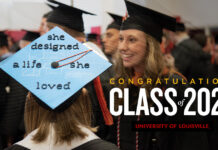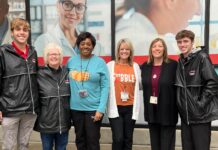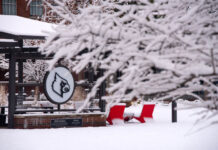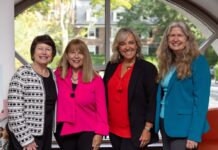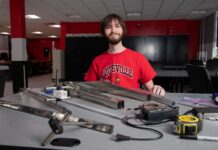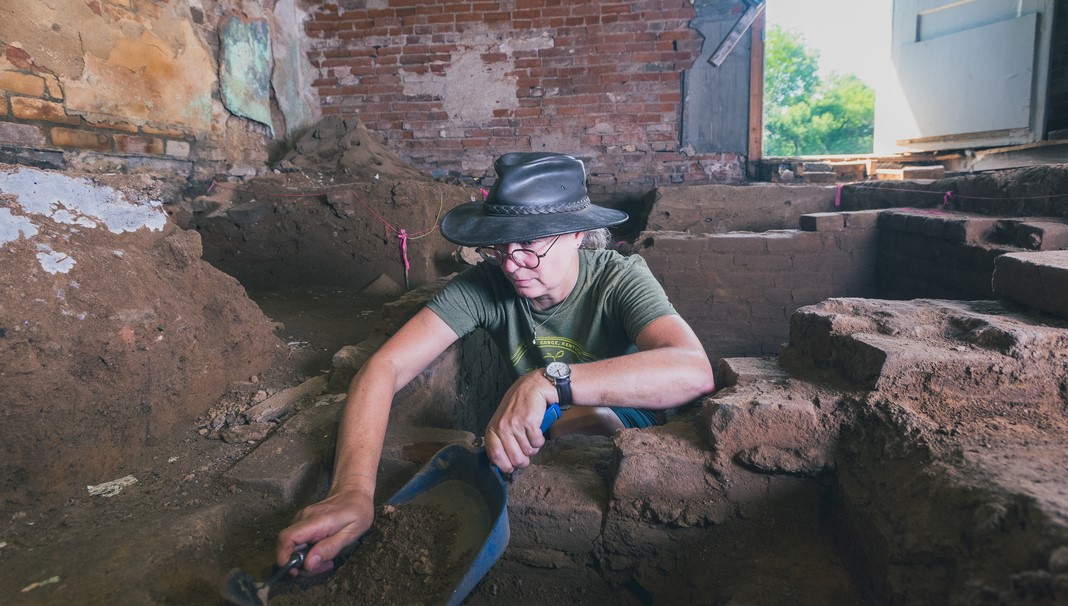When you think of an archaeologist, chances are the first image that comes to your mind is the iconic Indiana Jones with his leather hat, jacket and whip. Alums and archaeologists Lori Stahlgren ’93 and Jay Stottman ’92 say the job is slightly less adventurous than Steven Spielberg would have us believe, but is still exciting and impactful.
“We don’t get chased by Nazis like in the movies, but we do wear the hats,” Stahlgren said with a smile. “They actually serve a purpose — they block out the sun in the summer heat and protect us from ticks that could fall from trees when we’re working in forests.”
“And they look cool,” Stottman quipped.
But the pair didn’t get into archaeology just to look cool. They got into it to change perceptions.
Stahlgren and Stottman are part of the Kentucky Archaeological Survey (KAS) and work to uncover obscure information about the past that can expand the public’s idea of
local and statewide history. Their work is already making an impact.
While digging at the Bullitt family’s historic Oxmoor Farm in Louisville for the past few years, Stahlgren and Stottman uncovered a deeper understanding of the enslaved people who once lived there. Oxmoor, built in 1791, was home to five generations of the Bullitt family, who were influential in the formation of Kentucky and owned more than 100 slaves.
“What we learn about the past has implications for people today,” Stottman said.
PATHWAYS TO DISCOVERY
The current dig began when Oxmoor Farm decided to turn the slave dwellings into museum space and enlisted KAS. Based out of Western Kentucky University’s folk studies and anthropology department, KAS was founded in 1995 with the mission to provide a service to state and federal agencies, work with private landowners to protect archaeological sites and educate the public about Kentucky’s archaeological heritage. Stahlgren serves as a KAS project archaeologist while Stottman is assistant director of the survey.
“It’s research-driven now, but it started out as cultural resource management,” Stottman said of the dig. “We wanted to make sure we wouldn’t disturb any archaeological deposits, but the goal shifted when we started to find great artifacts.”
One of those noteworthy deposits was a machete Stahlgren found in one of the slave cabins. While the team hasn’t settled on what the machete’s purpose was, Stahlgren said it may have been kept in secret by the enslaved people living there to provide a sense of safety.
Other artifacts dug up in the slave dwellings include thimbles, crochet hooks and other sewing items, which may have been used by Louisa Taylor, a Black woman who was enslaved by the Bullitt family for most of her life.
While the digging is the most common aspect people visualize when thinking of archaeology, Stottman said there is much more behind the scenes work.
“Digging is actually a small part of what we do,” he said. “We spend most of our time washing and cataloging and analyzing artifacts, then writing about them and interpreting them.”
Stottman and Stahlgren both have a strong tenacity for discovery and spent time teaching anthropology at their shared alma mater, UofL, before finding their callings working with KAS. They did, however, take different turns to get to the survey.
Stottman went a more traditional route, earning anthropology degrees from UofL and University of Kentucky. Stahlgren’s path to archaeology was less direct. She earned a photography degree from WKU and graduated from UofL with a law degree before arriving at archaeology.
“I think my parents were shocked when I said I wanted to do archaeology, but I knew I
was passionate about this,” Stahlgren said.
HANDS-ON EDUCATION
Stottman and Stahlgren share their passion by providing on-the-ground educational experiences to students in the field, the lab and the community.
UofL students in professor Felicia Jamison’s Intro to Comparative Humanities class worked with the Filson Historical Society, UofL’s Oral History Center and KAS to participate in the excavation and research of the slave dwellings at Oxmoor Farm.
Hayley Salo, a UofL doctoral student in comparative humanities, used a trowel to dig, sorted and labeled artifacts and learned first-hand about the excavation processes, data collection methods and the meanings of what she found with guidance from Stottman and Stahlgren.
“We were looking for evidence of a pit cellar, and when we found variations in the dirt color and composition, they explained that was likely evidence of one,” Salo said. “Sometimes the differences were hard to see, but it got easier with practice. This was my first real hands-on project, and it reaffirmed my interest in public history and public-facing positions.”
Salo became fascinated by the sewing artifacts found, sparking her to investigate further by writing an article that analyzes the experiences of enslaved women who sewed clothes at Oxmoor Farm. She incorporated the archeological work done by Stahlgren and Stottman into the study.
Katie Cross Gibson, a UofL student working toward her master’s in interdisciplinary humanities, worked with the Oral History Center to interview a descendant of Louisa Taylor.
“Her oral history is part of a bigger initiative to record and amplify the lives of Louisa and other people who were enslaved by generations of Bullitts – to honor them with more than a few lines or entries in letters and ledgers,” Cross Gibson said. “We are not the main authority, but we are helping amplify Louisa’s and her family’s histories and stories.”
For Cross Gibson, participating in the oral history work was a life-changing experience she believes can empower people with the knowledge and means to support their communities.
“This kind of experiential learning is invaluable and gets at the heart of public history and humanities,” Cross Gibson said. “This is exactly the type of social justice-oriented, local history work I want to participate in over the course of my life, and collaborating on this project reinforced that goal.”
LINKING THE PAST TO THE PRESENT
While the work is helping to shed light on the shadows of our history, Stottman said there
are still people who don’t understand the significance of archaeology in today’s world.
“People ask me why we have to do archaeology of this time period if we have pictures and maps and documents already,” Stottman said. For example, the Bullitt family kept many documents, including family letters, lists, receipts and records of the enslaved people who lived at Oxmoor. But Stottman said the problem is not everyone was written about.
“The documents we have are reflective of the ones doing the documenting, and those were the people in power,” he said. “So enslaved people, immigrants, women, children, people from mental institutions … we have to work to learn about those groups because we only know about them from someone else’s perspective.”
This can create an unreliable and one-sided narrative of the past, particularly when it comes to slavery. Through their work, Stottman and Stahlgren aim to keep the past relevant to today’s issues by uncovering and expanding public understanding of the history of enslaved people.
“Our work is definitely in the realm of social justice,” Stahlgren said.
Stottman said archaeology levels the playing field of history by using artifacts enslaved people had, bought and used to give us a more direct idea of what their lives were like.
“Archaeology, in a way, democratizes the past,” Stottman said. “So even if their voices weren’t heard then, now their voices can be heard through the artifacts.”













